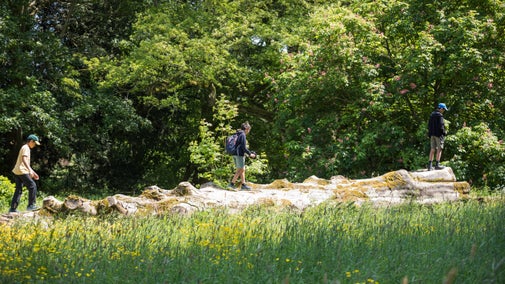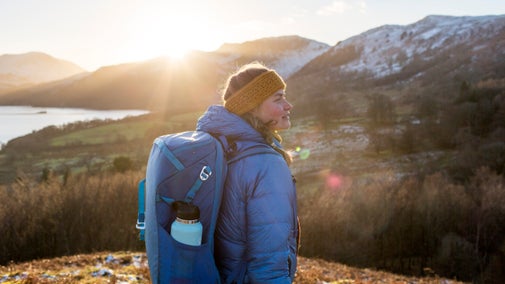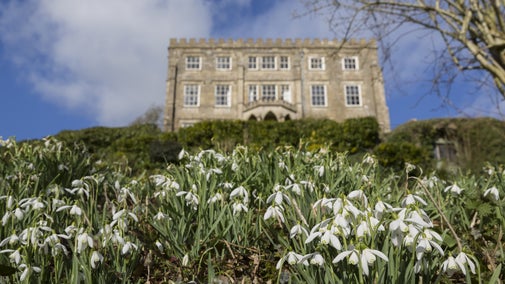
Discover Crickley Hill
Find out when Crickley Hill is open, how to get here, the things to see and do and more.

We're working in partnership with Gloucestershire Wildlife Trust to encourage and improve the wildlife throughout the seasons, and there are many birds, trees and other examples of wildlife to see during a visit to the hill.
Sitting behind the café at the top of Crickley Hill is an area affectionately known as The Scrubbs. The Scrubbs have been designated as a Site of Special Scientific Interest due to the trees and wildlife this small, but incredibly important piece of land supports.
The large mature beech trees are an important habitat for beetles, some of which are recorded nowhere else in the country. The woodland is of national importance for its saproxylic beetles. Beech, ash, hazel and whitebeam are some of the trees that grow here, and plants such as dog's mercury and sanicle thrive where the ground is undisturbed.
Den building, although fun, is damaging the fallen deadwood and root plate of the trees that grow in The Scrubbs, and so we keep The Scrubbs a den building-free zone. We've been taking dens down to help protect the woodland and the wildlife that live here.
Please help us to help the ancient and veteran trees in this Site of Special Scientific Interest by leaving deadwood where it lies.
When dens are built, large pieces of wood are moved and leaned against weak branches or other trees. These pieces are often loose and can easily fall. Fallen wood under a tree can be a sign that the tree is stressed. While we monitor the trees by the waymarked paths, many are left for nature to take its course.
Many flowers and plants are trampled when branches are collected for den building. Some important species have disappeared or retreated from areas where they should be thriving. Young tree stems are also easily snapped and can be torn from the ground.

If trees could talk, can you imagine the tales they might tell? Perhaps your tree has stood tall through battle scenes, or helped new friends to build a den? Has it heard the ‘chee-chee’ cries of baby birds in spring, or felt the winter snow build walls on its outstretched branches?
When it's pouring with rain, what could be better than chucking on your wellies and waterproofs and zooming around in the puddles, soaking up all the watery fun? Going welly wandering is No. 6 of our '50 things to do before you're 11¾'.
Mushrooms and toadstools love to grow in damp, dark and murky places best. Look for them on old or fallen trees to tick off no. 22 on the list of ‘50 things’. Please don’t touch fungi you find in the wild, unless you are with an expert and they say it’s okay.

The woods are home to many different types of birds. If you're very quiet, you may be lucky enough to spot a nuthatch. Creeping up and down the beech trees, they're on the lookout for insects, beechmasts and other nuts. You're more likely to hear them before you spot them as they can be very vocal.
Listen out for the laughing call from the green woodpecker. You can spot them flitting between the oak trees in Shortwood. They love to eat ants and will use their strong beak to probe straight into an ant colony.
Kestrels are a common sight on Crickley Hill as they hover over the land on the hunt for their next meal. Mixed flocks of tits and finches are also common in the woods. Long-tailed tits wander the woods and hedgerows in small, excitable flocks.
We share joint ownership of the land at Crickley Hill with Gloucestershire Wildlife Trust. We work together as custodians of this delicate place to ensure it is protected for the enjoyment of everyone, for ever.
Gloucestershire Wildlife Trust manage the car parks, café and toilets. To help raise vital funds to support their conservation work, there are charges in place for parking. They also run a full programme of wildlife-themed activities and events.
Crickley Hill is one of the best examples of limestone grassland in the country. Its wide variety of wildflowers during the summer has resulted in it being designated as a Site of Special Scientific Interest. Yellow wort, carline thistle, autumn gentian and clustered bellflower all thrive here. The wildflowers in return encourage butterflies like the Chalkhill Blue.

Find out when Crickley Hill is open, how to get here, the things to see and do and more.
Find out all you need to know about walking your dog on Crickley Hill in Gloucestershire and the surrounding Cotswold countryside. Crickley Hill is a one pawprint rated place

From brutal battles to an Iron Age hillfort, Crickley Hill is full of history. Explore a place rich in wildlife and archaeology.

At the top of Crickley Hill, behind the café, is an area of woodland known as The Scrubbs. A site of Special Scientific Interest, you’ll discover ancient and veteran trees.

Discover how the grazing of Belted Galloway cattle is essential to the conservation of the grassland at Crickley Hill, and how they help wildlife to flourish.

Plan a visit to one of the special countryside places in our care and discover the benefits of being in the great outdoors. Pack your walking boots and get ready to explore woodlands, valleys and rivers.

Explore some of the finest landscapes in our care on coastal paths, accessible trails, woodland walks and everything in between. Find the best places to walk near you.

There are plenty of things to do in Gloucestershire and the Cotswolds, from visiting historic gardens, to exploring houses and ancient sites amongst a patchwork of commons, woods and valleys. Start planning your visit for all the family to enjoy.
